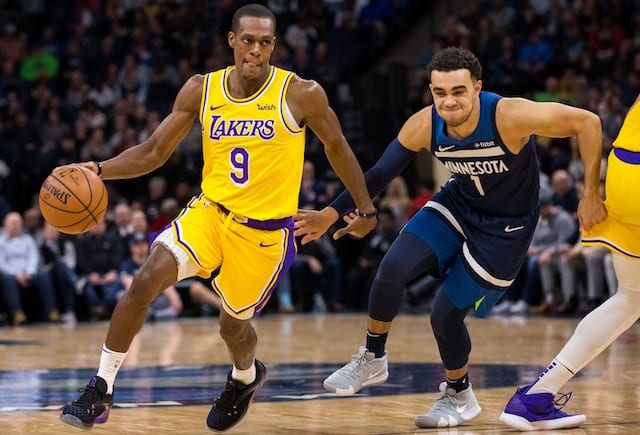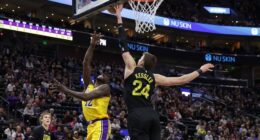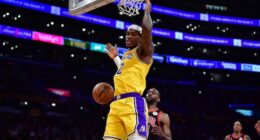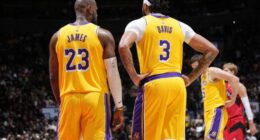
LA’s first win of the season over a dismal Pistons team came in a game where Bryant took 10 shots. In fact, three other Lakers (Howard, Metta World Peace, Pau Gasol) all had more shot attempts than Bryant. His 10 shots accounted for just 12.9 percent of the team’s total (77 FGA). Even if you take out the final eight minutes, in which the team emptied the bench and filled the court with reserves that never see the court, you’re looking at approximately 8.3 shot attempts for the other eight regular rotation players besides Bryant. A little easier to get into a rhythm with more attempts, right?
Nov. 11, 2012: Lakers vs. Kings
In the game the Lakers actually won against the Kings this season Kobe took just 15 shot attempts, and actually only made six of them. He led the team in shot attempts, albeit by only one, but accounted for just 22 percent of their total shot attempts. Again, accounting for the minutes played by non-regular rotation players, the rest of the team had an average of 8.25 shot attempts each. Kobe also had six assists in this game, and turned it over only twice.
Nov. 18, 2012: Lakers vs. Rockets
Los Angeles won this game 119-108 behind 22 points from Kobe. He shot 9-18 in this one, and recorded his first triple-double of the season. His 11 assists were a season high, and committed just three turnovers. His 18 field goal attempts accounted for 21 percent of the team total. And, you know where I’m going with this by now, right? The rest of the Lakers had an average of 8.4 shot attempts to share amongst them (when you take Robert Sacre’s one minute and 0-0 FGA attempts off the books).
—————————————-
So by now I’m thinking you’re beginning to notice the patterns and the trends in the Lakers in games that they win compared to the ones that they lose. It isn’t necessarily Kobe scoring 30 points that’s the problem, it’s the amount of shot attempts that he requires to reach those 30 points. Every shot that Bryant takes is one that one of his teammates doesn’t get, which seems to take them further and further out of the game mentally.
Now, I’ll be the first to admit that you can’t blame Kobe for this. His mental competitiveness and undying will to win are what set him apart from so many other players in this league. It’s unfair to expect the other players on the team to share that same sort of mindset, but some of this also falls on Kobe to learn the best way to get his teammates involved, even if it requires using tactics that may be different from what he’s accustomed to himself, or what he thinks he would want if he were one of them.
Part of being a leader is understanding those that you’re leading, and that’s where I think Kobe is falling a bit short here. With every loss it becomes more and more apparent that when Kobe dominates the ball the rest of the team doesn’t respond in the way that they should.

The simple answer is a resounding no. All movement on the court stops. It becomes the Kobe Show while four other players stand idly by, waiting for him to take the shot and shrug off the results.
But the more discouraging thing is when another player besides Bryant has the ball. The same thing happens. One player takes the ball, dribbles too much and takes a shot. Four other players stand around and watch. This, in my opinion, can be directly linked back to the habits they’re developing when Kobe has the ball. While you can criticize the team’s supporting cast for not playing with the same amount of effort or intensity that Kobe does, it’s still up to Bryant to figure out what the best method to get those players involved is.
—- How big of a fan are you? Show off your knowledge with our Ultimate Laker Fan Quiz! —-
And, judging by some of the statistics that I shared earlier, the more shots the supporting cast gets the more involved they tend to be in the game as a whole. Which, realistically, makes perfect sense. When a player is engaged on one end of the ball, and is doing whatever it takes to get in position to score or help a teammate score on one end of the floor they’re going to be more engaged on the other end as a result. Sure, many of the team’s problems this season have been on the defensive end, but I truly believe that a lot of that is simply because they’re not engaged enough in the game offensively to exert their full effort on the other end of the floor.
So what’s the answer? Is it as simple as having Kobe score less than 30 points? Of course not. Honestly, I believe that Kobe’s best asset is his ability to score the ball, and I doubt many people will argue with me there. But he can still score the ball at a high rate while getting his teammates involved.
Let’s take a look at the one game this season in which Kobe scored 30 points and the Lakers won.
Nov. 16, 2012: Lakers vs. Suns
Other than the Nov. 30 beating of the Denver Nuggets, this was easily the best game the Lakers have played this season. Kobe scored 31 points on 10-24 shooting. On paper, that’s not the best game from Bryant when you consider the sub-50% shooting. But those numbers are deceptive. Why? Because the rest of the team still managed to account for 65 shot attempts, which accounted to about 8.5 FGA per player. Bryant also has six assists that night, and made it a priority to get his teammates involved in the offense. The result? A more engaged team all-around, and a team that worked harder on both ends of the floor as a result.
—————————————-
So you see? It isn’t that Kobe’s 30-point games are bad for the Lakers because he’s scoring 30 points, it’s because as a result of most of these high-scoring affairs he’s leaving the rest of the players with no sense or purpose or urgency. When players like Jodie Meeks or Antawn Jamison only get 3-4 shot attempts from the field it’s hard for them to be productive, not to mention consistent. They’re unable to build up any confidence, and as a result they press more and more, because they don’t know when they’re going to get the ball back if they miss a particular shot.
The differences in how the team performs when the players not named Kobe average over eight shots compared to when they get less than eight shots is remarkable. Don’t believe me? Let’s take a look at every game they’ve played so far this season, and the team’s record when the supporting cast gets over eight shot attempts per non-Kobe player and how they do when they get less than eight.
Are you ready?
Next Page: Looking At Stats From Every Laker Game This Season





